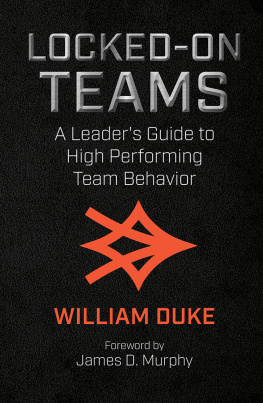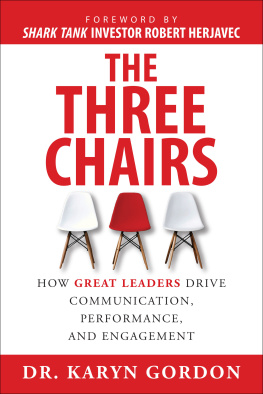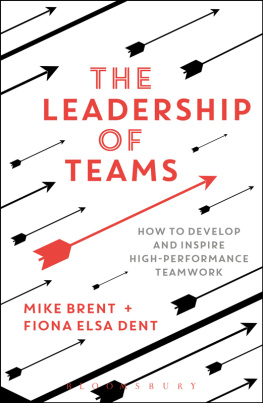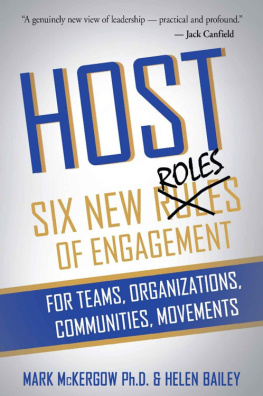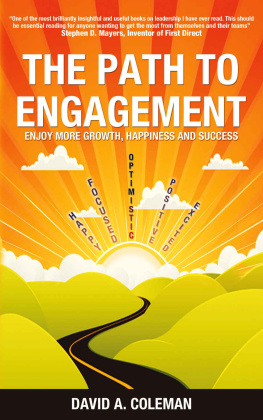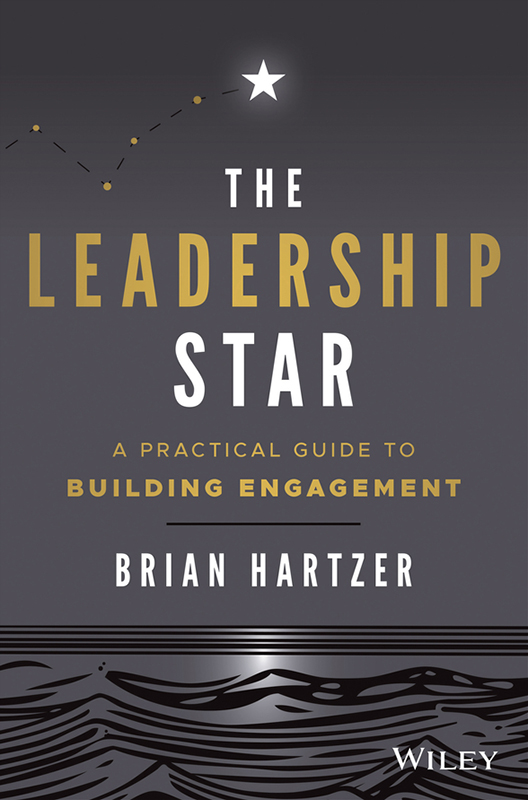
Table of Contents
List of Tables
- Chapter 3
- Chapter 7
- Appendix A
List of Illustrations
- Chapter 8
Guide
Pages
THE LEADERSHIP STAR
A PRACTICAL GUIDE TO BUILDING ENGAGEMENT
BRIAN HARTZER

First published in 2021 by John Wiley & Sons Australia, Ltd
42 McDougall St, Milton Qld 4064
Office also in Melbourne
John Wiley & Sons Australia, Ltd 2021
The moral rights of the author have been asserted
ISBN: 9780730390831

All rights reserved. Except as permitted under the Australian Copyright Act 1968 (for example, a fair dealing for the purposes of study, research, criticism or review), no part of this book may be reproduced, stored in a retrieval system, communicated or transmitted in any form or by any means without prior written permission. All inquiries should be made to the publisher at the address above.
Cover design and images by Wiley
Disclaimer
The material in this publication is of the nature of general comment only, and does not represent professional advice. It is not intended to provide specific guidance for particular circumstances and it should not be relied on as the basis for any decision to take action or not take action on any matter which it covers. Readers should obtain professional advice where appropriate, before making any such decision. To the maximum extent permitted by law, the author and publisher disclaim all responsibility and liability to any person, arising directly or indirectly from any person taking or not taking action based on the information in this publication.
For Jim Hartzer
Who, through the way he lived his life,
taught me all the important lessons in this book
even though it took me 30 years to realise it.
ACKNOWLEDGEMENTS
This book would not have been possible without inspiration and assistance from a number of people who have helped me develop these concepts over the past two decades.
I have been blessed to work with and learn from many talented executives over the yearsall of whom have contributed in important ways to the making of this book.
In my ANZ days, Damian Cotchett, Fiona Ryan, Miriam Silva, Barbara Wilby, Peter Hawkins, Sonya Clancy, Louis Hawke, John Harries, Greg Camm, John Connolly and John McFarlane all taught me important lessons about leadership. More recently I have been fortunate to learn from inspirational CEOs such as Stephen Hester, Ross McEwen, Gail Kelly, David Morgan, Bob Joss, Alan Joyce, Sir Ralph Norris and Jamie Dimon.
While the Leadership Star framework in this book predates my time at Westpac, I am grateful for the enthusiastic contributions and support from Westpac's Human Resources and Communications teams.
In writing the book, I am particularly grateful to Marj Lefroywho first encouraged me to write this book more than a decade ago and contributed some early drafting.
I would also like to thank Satyendra Chelvendra (Chelvi), Carl Sparks, Tim Ford, Barbara Wilby, Joel Pearce, Carolyn Hartzer Pearce, Stephen Hester, Bob Joss, Sir Ralph Norris, Ryan Stokes, Craig Tapper and Maurizio Floris, who all read drafts, shared insights, ideas and stories, and whose feedback was invaluable in helping me sort out my thinking. This book is immensely better for their generosity in sharing their wisdom and experience with me.
I'd also like to thank Jeanne Ryckmans, Allison Hiew, Lucy Raymond, Chris Shorten and the whole team at John Wiley & Sons for helping turn my initial manuscript into a fully fledged book that will hopefully benefit future leaders.
Finally, I'd like to thank my amazing wife, Georgy, and our wonderful children for their continued love, support and confidence in me over the pastchallenging12 months.
PREFACE
This book is designed to help leaders at all levelsfrom newly minted team leaders to established CEOsto build and sustain highly engaged teams.
It presents a fivepoint framework that I call the Leadership Stara visual memory device I created to help me recall and apply engagement lessons that I'd learned through trial and error and from watching great leaders in action. As a selftaught leaderI don't have an MBAthese lessons were collected over a 30year career in banking that spanned roles on four continents and culminated in my time as CEO of Westpac from 2015 to 2019.
While my experience has predominantly (though not exclusively) been in a commercial, financial services setting, feedback from other leaders with whom I've shared these lessons convinces me that they apply equally to government, academic, community and notforprofit organisations as well.
Although many of the stories in this book are drawn from my time at ANZ, Royal Bank of Scotland and Westpac, this is not a book about those companies or my time as CEO of Westpac.
Because of the circumstances of my departure from Westpacwhich I touch on briefly at the end of this bookI am conscious that some people may dismiss what I have to say, or seek to highlight differences between the lessons in this book and what they see as my failings as a CEO.
While I am all too aware of my weaknesses, the experience of other leaders who have applied the Leadership Star convinces me that the model works. My hope is that, by sharing the lessons in this book, other leaders and their employees will benefit from the good bits and avoid some of the mistakes that I made along the way.
I've subtitled this book A practical guide to building engagement because it reflects my and other leaders actual experience in applying this framework to our daily work lives. While this book contains many specific ideas and suggestions, the good news is you don't need an MBA to understand it or get started. It's designed to be simple enough that you can carry the five points around in your head, while being nuanced enough to help you diagnose and take action on things that may be holding your team or business back.
So whether you're new to the challenge of leadership, an experienced leader, or an established CEO who needs a structure against which you can assess your current approach, this book is for you.
Brian Hartzer
Sydney, October 2020
INTRODUCTION
But what do I personally need to do?
There was a long pause, and the two human resources experts on the other side of the table stared back at me, blankly.
We had just finished reviewing the latest results of the annual staff satisfaction survey for my business. The results were okay, but not great.
It was a typical survey: staff had been asked to rank on a scale of 110 their response to statements such as I enjoy my job, My manager recognises me for the work that I do and I rarely think about leaving.
The HR team had just finished presenting the results, organised in themes such as communications, staff recognition, training, manager quality and so on.
Some areas had improved, most had stayed the same and a couple had declined.
But there was little in the way of practical suggestions about what we as a business leadership team could do to improve the resultslet alone where I as the head of the business could intervene to improve things.
Next page

